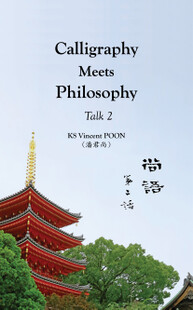Withstand and Endure, with Kuiji's Annotations
(堪忍, 窺基贊文)
51 X 31 cm in Cursive Script (草書), Small Standard Script (小楷書)
Translation
1. 堪忍.
Withstand and Endure. (Cursive Script)
2. 《妙法蓮華經》贊曰 :
As annotated (by Kuiji) in Lotus Sutra (1): (Small Standard Script)
3. 梵云索訶, 此云堪忍.
In Sanskrit, this is "Saha (索訶)". Here, it is "Withstand and Endure (堪忍)".
4. 諸菩薩等行利樂時, 多諸怨嫉, 眾苦逼惱.
When various Bodhisattvas (菩薩) act to benefit all of the present (樂) and future (利)(2), they encounter all sorts of discontent (怨嫉), countless (眾) suffering, and aggravating anguish (逼惱) .
5. 堪耐勞倦而忍受故,
Due to (故) them being able to withstand (堪耐) weariness and endure (忍受) it,
6. 因以為名.
hence, a Bodhisattva is crowned this title (名,3).
FOR FURTHER TRANSLATION, FOOTNOTES, AND ELABORATIONS
PLEASE SEE :

Calligraphy Meets Philosophy - Talk 2 尚語 - 第二話
by KS Vincent POON (Aug. 2023)
ISBN 978-1-989485-32-3
Content is the soul of an artwork.
Thus, catching the soul of Chinese calligraphy requires understanding the literary contents. To facilitate this, the Calligraphy Meets Philosophy series presents traditional Chinese calligraphy alongside line-by-line translated texts with remarks and footnotes.
Calligraphy Meets Philosophy – Talk 2 (《 尚語∙第二話 》) includes calligraphies and translations of selected literary works by Cao Cao (曹操, 155-220 AD), Zhuge Liang (諸葛亮, 181-234 AD), Yen Shang (楊慎, 1488–1559 AD), Bai Juyi (白居易, 772-846 AD), Li Bai (李白, 701-762 AD), The Nun of the Wujinzhan (無盡藏比丘尼, ?-?AD), Wuzu Fayan (五祖法演, ?-1104AD), Longya Judun (龍牙居遁, 835-923 AD), and Kuiji (窺基, 632-682 AD).The book concludes with the author’s artwork of the entire Diamond Sutra (《 金剛般若波羅蜜經 》), followed by a short remark.
WorldCat/Library: [U of Oxford] [U of Cambridge] [Kyoto U] [Columbia U] [HKU] [National Palace Museum Taiwan] etc...
Jump to: Buddhism
Jump to: Works in Cursive Script